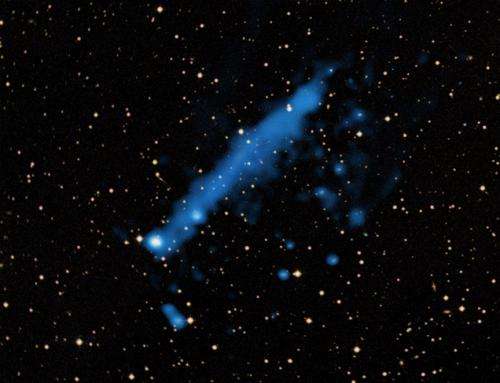A pulsar's mysterious tail

(PhysOrg.com) -- A spinning neutron star is tied to a mysterious tail -- or so it seems. Astronomers using NASA's Chandra X-ray Observatory have found that this pulsar, known as PSR J0357+3205 (or PSR J0357 for short), apparently has a long, X-ray bright tail streaming away from it.
This composite image shows Chandra data in blue and Digitized Sky Survey data in yellow. The position of the pulsar at the upper right end of the tail is seen by mousing over the image. The two bright sources lying near the lower left end of the tail are both thought to be unrelated background objects located outside our galaxy.
PSR J0357 was originally discovered by the Fermi Gamma Ray Space Telescope in 2009. Astronomers calculate that the pulsar lies about 1,600 light years from Earth and is about half a million years old, which makes it roughly middle-aged for this type of object.
If the tail is at the same distance as the pulsar then it stretches for 4.2 light years in length. This would make it one of the the longest X-ray tails ever associated with a so-called "rotation-powered" pulsar, a class of pulsar that get its power from the energy lost as the rotation of the pulsar slows down. (Other types of pulsars include those driven by strong magnetic fields and still others that are powered by material falling onto the neutron star.)
The Chandra data indicate that the X-ray tail may be produced by emission from energetic particles in a pulsar wind, with the particles produced by the pulsar spiraling around magnetic field lines. Other X-ray tails around pulsars have been interpreted as bow-shocks generated by the supersonic motion of pulsars through space, with the wind trailing behind as its particles are swept back by the pulsar's interaction with the interstellar gas it encounters.
However, this bow-shock interpretation may or may not be correct for PSR J0357, with several issues that need to be explained. For example, the Fermi data show that PSR J0357 is losing a very small amount of energy as its spin slows down with time. This energy loss is important, because it is converted into radiation and powering a particle wind from the pulsar. This places limits on the amount of energy that particles in the wind can attain, and so might not account for the quantity of X-rays seen by Chandra in the tail.
Another challenge to this explanation is that other pulsars with bow-shocks show bright X-ray emission surrounding the pulsar, and this is not seen for PSR J0357. Also, the brightest portion of the tail is well away from the pulsar and this differs from what has been seen for other pulsars with bow-shocks.
Further observations with Chandra could help test this bow-shock interpretation. If the pulsar is seen moving in the opposite direction from that of the tail, this would support the bow-shock idea.
These results were published in the June 1st, 2011 issue of The Astrophysical Journal. The first author is Andrea De Luca of Institute of Advanced Study in Pavia, Italy (IUSS), the National Institute of Nuclear Physics (INFN) in Rome, and the National Institute for Astrophysics (INAF) in Milano.
More information: De Luca, A et al, 2011, ApJ 733:104D; arXiv:1102.3278
Provided by Chandra X-ray Observatory


















